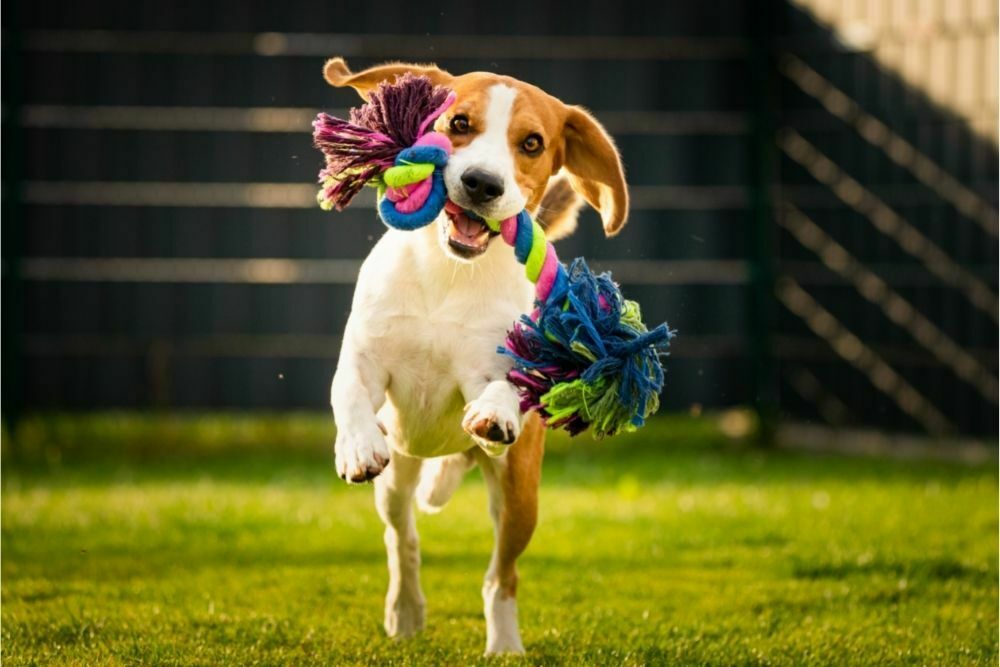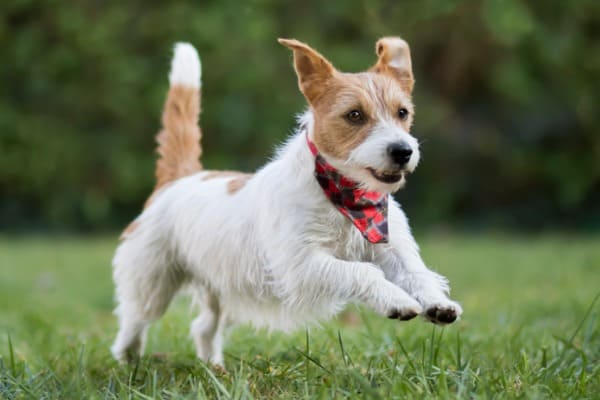If your dog has recently been spayed, you may be wondering how active they can be soon after the operation. Firstly, if you’re unfamiliar with what spaying is, it involves the removal of either the womb from a female dog or the ovaries and uterus.

There are many benefits to getting your dog spayed, such as reducing the risk of your dog getting mammary cancer, otherwise known as breast cancer, and eliminating the chance of your dog getting ovarian or uterine cancer. It is often seen as the socially reasonable thing to do.
Once your pooch has been spayed, you must ensure they are cared for properly over a set period of time. Your dog will require time to heal, so there will be many restrictions immediately after surgery.
However, getting your dog to take it easy after being spayed or neutered is no easy feat. This is especially true if they are still a puppy who needs to exert high levels of energy they have.
Most dogs want to get up and start playing soon after being spayed, but they don’t understand how much rest and recovery they need. Therefore, you should keep their running and playing in check.
If your dog has been spayed or will be in the near future, and you need to know how soon they can play and run after the operation, continue reading. Just remember, all dogs are different. Always ask your veterinarian for professional advice for your particular breed of dog.
So, the question remains, can your dog run around soon after being spayed? Dogs should not play or run for approximately 10 days post-spay surgery. Once these 10 days are up, most dogs should have recovered sufficiently to resume their usual levels of physical activity.
To find the detailed answer to this question and more, we sought advice from professional veterinarians. Find out more below.
When is it safe for my dog to play after being spayed?
This can vary from one dog to the next, but the general advice is for a dog to rest for 2 days after spaying. It is not recommended that you play with your dog during the first 48 hours after spaying. It is advised that until the 3-day check-up after surgery, no play or activity should take place at all, to be on the safe side.
Once these two or three days are up, however, it should be okay for you to take your dog on some short leash walks up until the 10-day check-up. They should be kept on a short leash to prevent any running, as this should still be avoided during this period.
As we mentioned, each dog is different, so we recommend that you seek advice from your veterinarian who knows your specific dog.
What distance is my dog allowed to run after being spayed?
The answer to this question is a little tricky, as no two dogs are the same. Each one requires different exercise patterns and levels. Nonetheless, once your dog has healed after 10 days, your dog should be able to run as far as they normally could before spaying.
They shouldn’t run at all during the first 10 days, but if they do, it should be over very short distances. (Easier said than done, right?)
Dangers can arise if your dog doesn’t get enough rest after spaying or neutering surgery. Let’s take a look at some of these details below and some post-surgery care advice for your pup.
Caring for Your Dog After Spaying Surgery
The first 2 days
Spaying and neutering are quite large procedures, so your dog will need time to heal properly afterward. Veterinarians generally recommend that your dog completely rests for 24 to 48 hours after surgery. Therefore no running, playing, or any type of physical activity should take place during this time.
When we mean rest, we mean total rest. Your dog should not walk, run, stretch, or jump in the first two days post-op. This is a time for recovery and nothing else.
After the first 48 hours
48 hours after surgery, some dogs can be let outside for a little bit of exercise. This should be somewhere where you can keep a close eye on them, such as your backyard. Make sure they do not overexert themselves, so prevent running or jumping.
Not all dogs recover at the same rate. Therefore, while one dog may be able to walk around after the first 48 hours, others may need a little longer to recover.
3 to 10 days
This is when your dog should be getting regular check-ups. Most vets recommend that your pooch has 2 follow-up appointments on the third and tenth day after surgery. This allows the vet to inspect your dog’s recovery and to ensure they are healing properly.
During this period, your dog should not be having too much exercise. Light walks in a controlled area are recommended with no running or playing, but even this may be too much for some dogs.
After 3 days, you may be able to start taking your dog on short leash walks depending on how their recovery is going. After 10 days, your furry four-legged friend should now be back to normal but again, your vet’s advice determines this.
When you start taking your dog for a walk after surgery, you must make sure it is over a short distance over comfortable terrain such as flat tarmac. Start these walks very slowly and see how your dog copes with this exercise.
Gradually, you may be able to extend the distance you walk. However, your dog must remain on a short leash to avoid them running or disturbing their stitching and scar. Just take things easy until the tenth day is reached. Depending on your veterinarian’s advice, your dog should be able to run then. And boy, will they be happy!
After 10 days, most dogs are usually allowed to walk normally, run, and play just as they did before spaying. Of course, this isn’t always the case if the dog hasn’t recovered sufficiently and has had some complications.
Sometimes, the scar from the operation can take longer to heal than first thought. If this is the case, your dog may have to stay on antibiotics for a few more weeks.

Symptoms Your Dog May Experience Post-Surgery
All dogs react differently after the surgery. Some feel sluggish and just want to rest while others are hyper and can’t wait to go out and play. Let’s take a look at some of the behaviors dogs show after spaying.
Overly hyperactive
As we have mentioned, rest is critical during the first few days of recovery. If your dog wants to go out and play as before, you must stop them. This is quite normal because, well, they’re a dog.
They are usually young when they are spayed, so they have more energy than at any other time in their life. However, if they become too active, they run the risk of damaging the incision from the operation.
Try and keep your dog calm by staying around them. Give them loads of attention and love. (more than usual!) This will make them feel safe and more relaxed.
Loss of coordination from anesthesia
Anesthesia can result in your dog feeling weak and tired for quite some time after surgery. While they sleep, it is possible that they may vomit or pee. Sleeping in their own urine or vomit can cause an infection where the incision is, so this must be avoided. You can use a puppy pad underneath your dog to keep them clean and safe.
You may notice your dog is walking a little differently after being spayed. If this is the case, you should pick them up wherever you need to. Let them sit with you on the couch. This is all about making them feel safer and relaxed.
Caring for Your Dog After Spaying – Tips
There are a few things you can do at home to help your dog recover and get back to the level of exercise they were at before being spayed.
- Limit their activity – Keeping your dog confined will speed up the healing process. To do this, you can let them recover and rest in a smaller room where they cannot move around much and be as active. Some owners decide to keep their dogs in a cage during the first 2 days after surgery. They will only let them out for toilet breaks but if you decide to do this, you must provide a crate that is large enough for your pooch to turn around in and be comfortable.
- Help your dog burn off energy – Of course, most young dogs will have a lot of energy to burn, even during recovery. However, because they cannot do any physical activities, you should find other ways to burn this energy off. One method is to incorporate mental stimulation when you start going for your short-leash walks. You can do this by taking treats with you and then throwing them in front of your dog as you walk. This will help your dog maintain focus as they walk and limits any distractions from elsewhere. It’s not over-exertive but just enough to keep them active at the necessary level.
- Treat your dog’s scar and their stitches – Don’t worry, you won’t have to deal with much in this case. Your vet will handle just about everything here, but your job is to look out for any possible infections. This is usually in the form of oozing or crustiness. If this is evident, simply give it a wipe with a clean towel and then dampen with some warm water. Once you have done this, contact your vet for a more thorough check-up.
- Don’t leave your pooch alone for too long – While it is okay to leave your dog alone after spaying, this should only be for short periods. If you have to leave them alone for more than 30 minutes, keep your dog crated or in a small room with no hazards. Also, keep them away from other pets, especially dogs.
- Use antibiotics provided by the vet – Antibiotics are an essential part of recovery as they help ward off infections. If your vet has prescribed antibiotics for your dog (they usually do), you must make sure your pup finishes every pill, even if you think they seem better.
- Get a cone dog collar – This is to prevent your dog from licking their wound. The cone limits their movement so it will become almost impossible to reach the surgical area.
What age is best to spay my dog?
If you’re planning to spay your dog, the best time is before their first heat stage. This is when female dogs enter their reproductive cycle to mate with male dogs. It occurs twice a year when their estrogen levels increase. This usually happens at 6 to 24 months of age, so this is the ideal time for spaying.
In Summary
Although the spaying procedure is common, it is serious surgery. This is why you must take the proper precautions and follow the steps outlined above to ensure your dog recovers fully and as quickly as possible.
Always follow your veterinarian’s advice and visit them if any complications arise.
